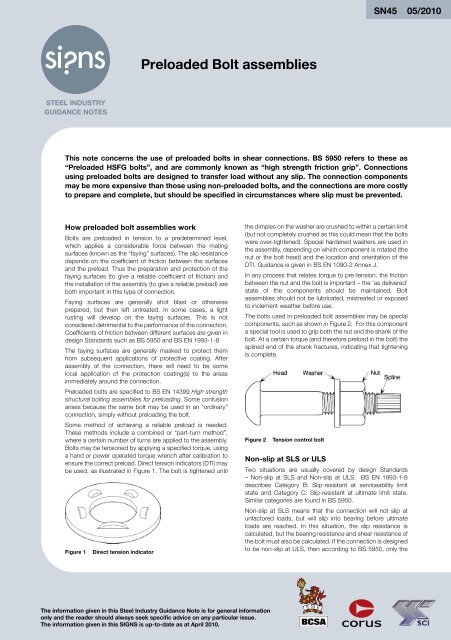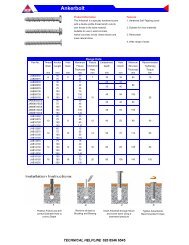Preloaded Bolt assemblies - SteelConstruction.org
Preloaded Bolt assemblies - SteelConstruction.org
Preloaded Bolt assemblies - SteelConstruction.org
Create successful ePaper yourself
Turn your PDF publications into a flip-book with our unique Google optimized e-Paper software.
SN45 05/2010<br />
<strong>Preloaded</strong> <strong>Bolt</strong> <strong>assemblies</strong><br />
STEEL INDUSTRY<br />
GUIDANCE NOTES<br />
This note concerns the use of preloaded bolts in shear connections. BS 5950 refers to these as<br />
“<strong>Preloaded</strong> HSFG bolts”, and are commonly known as “high strength friction grip”. Connections<br />
using preloaded bolts are designed to transfer load without any slip. The connection components<br />
may be more expensive than those using non-preloaded bolts, and the connections are more costly<br />
to prepare and complete, but should be specified in circumstances where slip must be prevented.<br />
How preloaded bolt <strong>assemblies</strong> work<br />
<strong>Bolt</strong>s are preloaded in tension to a predetermined level,<br />
which applies a considerable force between the mating<br />
surfaces (known as the “faying” surfaces). The slip resistance<br />
depends on the coefficient of friction between the surfaces<br />
and the preload. Thus the preparation and protection of the<br />
faying surfaces (to give a reliable coefficient of friction) and<br />
the installation of the assembly (to give a reliable preload) are<br />
both important in this type of connection.<br />
Faying surfaces are generally shot blast or otherwise<br />
prepared, but then left untreated. In some cases, a light<br />
rusting will develop on the faying surfaces. This is not<br />
considered detrimental to the performance of the connection.<br />
Coefficients of friction between different surfaces are given in<br />
design Standards such as BS 5950 and BS EN 1993-1-8<br />
The faying surfaces are generally masked to protect them<br />
from subsequent applications of protective coating. After<br />
assembly of the connection, there will need to be some<br />
local application of the protection coating(s) to the areas<br />
immediately around the connection.<br />
<strong>Preloaded</strong> bolts are specified to BS EN 14399 High strength<br />
structural bolting <strong>assemblies</strong> for preloading. Some confusion<br />
arises because the same bolt may be used in an “ordinary”<br />
connection, simply without preloading the bolt.<br />
Some method of achieving a reliable preload is needed.<br />
These methods include a combined or “part-turn method”,<br />
where a certain number of turns are applied to the assembly.<br />
<strong>Bolt</strong>s may be tensioned by applying a specified torque, using<br />
a hand or power operated torque wrench after calibration to<br />
ensure the correct preload. Direct tension indicators (DTI) may<br />
be used, as illustrated in Figure 1. The bolt is tightened until<br />
Figure 1<br />
Direct tension indicator<br />
the dimples on the washer are crushed to within a certain limit<br />
(but not completely crushed as this could mean that the bolts<br />
were over-tightened). Special hardened washers are used in<br />
the assembly, depending on which component is rotated (the<br />
nut or the bolt head) and the location and orientation of the<br />
DTI. Guidance is given in BS EN 1090-2 Annex J.<br />
In any process that relates torque to pre-tension, the friction<br />
between the nut and the bolt is important – the ‘as delivered’<br />
state of the components should be maintained. <strong>Bolt</strong><br />
<strong>assemblies</strong> should not be lubricated, mistreated or exposed<br />
to inclement weather before use.<br />
The bolts used in preloaded bolt <strong>assemblies</strong> may be special<br />
components, such as shown in Figure 2. For this component<br />
a special tool is used to grip both the nut and the shank of the<br />
bolt. At a certain torque (and therefore preload in the bolt) the<br />
splined end of the shank fractures, indicating that tightening<br />
is complete.<br />
Figure 2<br />
Tension control bolt<br />
Non-slip at SLS or ULS<br />
Two situations are usually covered by design Standards<br />
– Non-slip at SLS and Non-slip at ULS. BS EN 1993-1-8<br />
describes Category B: Slip-resistant at serviceability limit<br />
state and Category C: Slip-resistant at ultimate limit state.<br />
Similar categories are found in BS 5950.<br />
Non-slip at SLS means that the connection will not slip at<br />
unfactored loads, but will slip into bearing before ultimate<br />
loads are reached. In this situation, the slip resistance is<br />
calculated, but the bearing resistance and shear resistance of<br />
the bolt must also be calculated. If the connection is designed<br />
to be non-slip at ULS, then according to BS 5950, only the<br />
The information given in this Steel Industry Guidance Note is for general information<br />
only The information and the reader given should in this always Steel seek Industry specific Guidance advice Note on any is particular for general issue. information<br />
The only information and the reader given should in this always SIGNS seek is up-to-date specific as advice at April on 2010. any particular issue.
slip resistance is calculated. BS EN 1993-1-8 also requires<br />
the bearing resistance to be calculated.<br />
The common case is to design the connection to be non-slip<br />
at SLS (Category B in BS EN 1993-1-8), and is recommended.<br />
Design to be non-slip at ULS may be employed on hybrid<br />
connections where load is shared between bolts and welds<br />
in the same connection, in connections using slots, and in<br />
connections that provide restraint to other members – i.e.<br />
where slip before ULS would lead to a loss of stability.<br />
Used <strong>assemblies</strong><br />
In some cases, connections are disassembled. In these<br />
circumstances, the assembly should not be re-used,<br />
because some of the bolt’s (limited) elongation will have<br />
been irreversibly used. Preloading an assembly for a second<br />
time may take the assembly to (or very close to) its breaking<br />
point.<br />
Circumstances when preloaded bolt<br />
<strong>assemblies</strong> should be used<br />
In general, non-preloaded bolts are perfectly satisfactory for<br />
the majority of orthodox connections, as the small amount<br />
of slip associated with clearance holes has no practical<br />
consequences for the structure. There are a few circumstances<br />
where the use of preloaded bolt <strong>assemblies</strong>, despite the<br />
perception of increased costs, should be considered:<br />
1. Where slip must be avoided<br />
Examples include a bolted truss, where slip in a splice<br />
connection would lead to additional deflection and<br />
an unsightly kink in the member. A splice in a moment<br />
resisting member may require friction grip <strong>assemblies</strong> to<br />
prevent unsightly deflection.<br />
2. Fatigue<br />
In structures where fatigue is a design consideration, the<br />
use of preloaded <strong>assemblies</strong> is recommended. The high<br />
level of preload means that the tension in the bolt does<br />
not vary significantly, provided the plies are stiff and in<br />
contact.<br />
3. Vibration<br />
Severe, continued vibration has been known to lead<br />
to ordinary (non-preloaded) bolt <strong>assemblies</strong> becoming<br />
loose. <strong>Preloaded</strong> bolts may be used when vibration is<br />
a concern. Other effective solutions exist to prevent the<br />
nuts from coming loose, including the use of lock nuts,<br />
nuts with nylon inserts, or split pins. It should be noted<br />
that nuts working loose due to vibration is not normally<br />
a consideration in orthodox building structures, and in<br />
most cases no special measures are required.<br />
4. Load Reversal<br />
When load reversal occurs (excluding reversal solely from<br />
wind loading) the possibility of slip in the connections<br />
(as the clearance holes allow movement to and fro)<br />
should be prevented. Significant reversal may take place<br />
in structures supporting moving loads such as cranes.<br />
Friction grip <strong>assemblies</strong> are recommended in these<br />
situations.<br />
Key Points<br />
1. Generally, for connections subject to shear, ordinary<br />
bolts in clearance holes are satisfactory – only use<br />
preloaded bolt <strong>assemblies</strong> where they are truly<br />
warranted.<br />
2. Generally design the preloaded bolt connections to be<br />
non-slip at serviceability.<br />
3. Faying surfaces should be protected until the<br />
connection is assembled – subsequent making good of<br />
protective coating will be required.<br />
4. Installation of preloaded bolt <strong>assemblies</strong> should be<br />
carefully monitored on site to ensure the <strong>assemblies</strong> are<br />
correctly pre-tensioned and not over-tightened.<br />
5. <strong>Preloaded</strong> bolt <strong>assemblies</strong> should be used in<br />
accordance with the manufacturer’s instructions – they<br />
should not be lubricated or mistreated.<br />
6. Used <strong>assemblies</strong> should be discarded.<br />
Further Sources of Information<br />
1. Cosgrove, T.C Tension Control <strong>Bolt</strong>s, Grade S10T, in Friction Grip Connections, SCI, 2004<br />
2. Owens, G. W and Cleal, B. D, Structural Steelwork Connections, Butterworths, 1989<br />
3. Steel Details, BCSA, 2005












